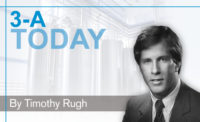Clean machines
Hygienic design of dairy equipment is in the spotlight
Hygienic machine design allows dairy manufacturers to minimize downtime and waste.

Bosch Packaging Technology is a supplier of process and packaging technology.




By Markus Schlumberger, Bosch Packaging Technology
As the mission of the 3-A Sanitary Standards goes, it’s all about food safety and public health. Dairy processors are seeking advanced hygienic design in filling and packaging machinery to prevent product recalls, while also simplifying cleaning and reducing product and material waste.
Food safety regulatory bodies such as the Food and Drug Administration and the Department of Agriculture dictate the quality of food substances sold, whereas entities such as the 3-A SSI focus on advancing hygienic equipment design. For example, 3-A SSI mandates that equipment that handles food should be designed for easy cleaning, sanitary processing and be free of areas that can trap product parts or contaminant. The 3-A standard, along with the Pasteurized Milk Ordinance (PMO), became the guideline for official food inspectors ruled by the FDA.
3-A SSI certificate gives assurance to dairy processors
In other words, the 3-A SSI certificate gives dairy processors an assurance that their product will be handled hygienically through the filling and packaging process, contributing to high product quality and ultimately consumer safety. Manufacturers also benefit from easy cleaning – a positive side effect of sanitary design. Equipment is streamlined to have fewer areas that can trap food and cause contamination. It is crucial that machines withstand vigorous cleaning and are self-draining. This ultimately saves time and labor costs.
Hygienic machine design allows food manufacturers to minimize downtime and waste, ensure consistently high product quality and focus on what they do best – develop and deliver fresh and safe products to consumers.
Current hygienic design standards in the U.S. dairy industry
There are two main organizations providing hygienic design certifications on both sides of the pond. The European Hygienic Engineering & Design Group (EHEDG) is a consortium of EU equipment manufacturers, research institutes and public health authorities. In the United Sates, the main organization is 3-A Sanitary Standards Inc. Both certifications have similar approaches; EHEDG and 3-A SSI have been working together for the past 20 years to create a uniformed set of hygienic design, testing and implementation standards. However, the main differences lie in the validation process.
In Europe the main criteria includes machine design and testing reviews, which must be undertaken in accordance with EHEDG guidelines and test methods. To obtain the 3-A certificate, applicants must undergo a third-party verification (TPV) inspection based on an on-site detailed physical evaluation of an operating system in a processing facility, which has to be renewed every five years. While the entire portfolio of Bosch’s dairy filling equipment is EHEDG-approved, we have recently received the 3-A SSI certification of our Ampack carousel filling machine. Its upgraded version has been available on the U.S. market since the beginning of 2016.
About the author
Markus Schlumberger, managing director sales at Ampack GmbH, oversees the sales process of the Ampack portfolio. Contact him by phone, +49 8231 6005-918, or by e-mail, markus.schlumberger@bosch.com. In the United States, contact Rich Müller at, Osgood Industries Inc., 813-792-4547 ext. 206 or rich.Mueller@bosch.com
Bosch Packaging Technology, based in Waiblingen, Germany, is a supplier of process and packaging technology. With 6,200 employees, the Bosch Packaging Technology division has more than 30 locations in more than 15 countries.
Looking for a reprint of this article?
From high-res PDFs to custom plaques, order your copy today!








